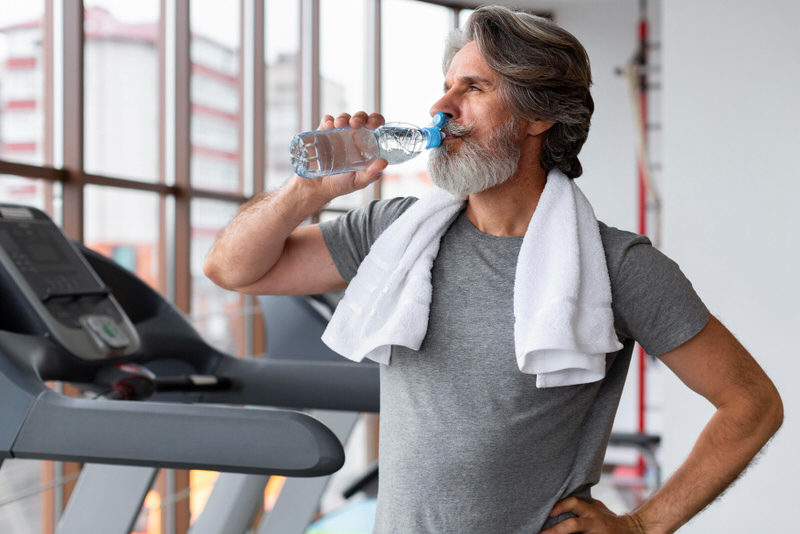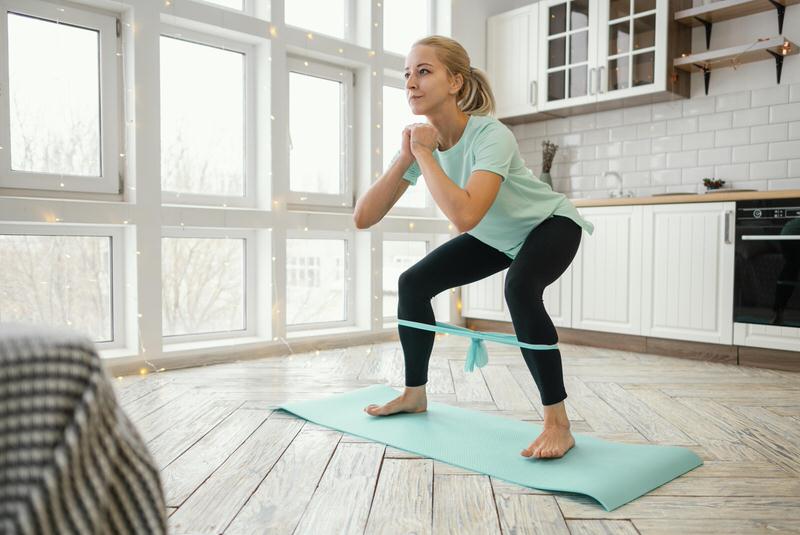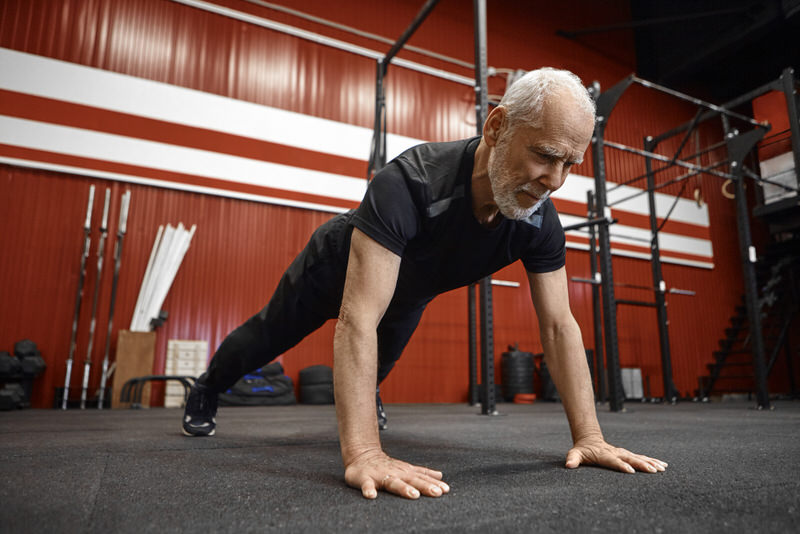It’s never too late to start building your muscles as you get older, even if you’re 60 years old. It’s just a bit harder to do because your body begins to reduce the number of hormones responsible for muscle growth when you pass your 30s. Finding a weight that can safely challenge you, working out with a proper form during each exercise, increasing your protein intake, and getting proper rest are key factors that can help you put on muscle regardless of how old you are.
If you’ve hit 40, then you probably know about the toll time takes on your body.
Your back hurts, your knees don’t bend as well as they used to, and your body seems to get sore much more easily.
To top it all off, it becomes tough to put on muscle, especially as you reach your 40s and 50s. Even if you eat clean and find the time to work out daily, it can still be challenging to put on muscle.
Is it okay to work out and lift weights once you reach your 50s? Are there any exercises you should avoid? At the very least, can you prevent muscle loss? Are your muscle-building days all behind you?
How do your muscles change as you age?

Most people work out to either lose weight/fat or build muscle. They hit the gym, lift weights, run on treadmills and drink protein shakes. And while most of us know that this works, how does it work?
Your muscle size increases because you create microscopic tears in your muscles every time you workout (especially if you push your limits).
This process is known as muscle hypertrophy, and once it happens, your body repairs these tears by fusing the damaged fibers, increasing the size of the muscle.
But for muscle growth to keep happening, the rate of muscle protein synthesis should be bigger than the rate of muscle protein breakdown.
The below table shows us how we can grow our muscles, regardless of our age.
| Do | Don’t |
|---|---|
| Have a small pre-workout snack such as a banana about 45 minutes before the workout. | Eat immediately before a workout. This might make your stomach feel bloated as your body will pump blood to your stomach to help digestion instead of the muscle. |
| Warm-up before working out. This helps prepare the muscle for working out and can help prevent injury. | Immediately start lifting weights. This can cause serious damage to your muscles. |
| Create a proper schedule. It doesn’t matter if you plan on working out for just a couple of days or every day. It’s important to plan which body parts and exercises you will do. | Skip working out on body parts (usually legs). This can cause your body to grow disproportionately, especially in the long term. |
| Use proper form. Your gym instructor can guide you, and you can also get all the help you need from YouTube. | Improvise or ego lift. Remember to always get the proper form down before increasing weights. |
| Push yourself; your muscles grow when you push your limits. | Overwork or underwork yourself. It’s always good to push but know your limits. Increasing the weight by a large amount at once is not recommended. |
| Keep yourself hydrated. Remember, you sweat a lot, and you need to drink a lot of water to replace the water you lost. | Avoid drinking water as this can make you dehydrated and even faint, which can be dangerous, especially if you’re lifting heavyweights. |
| Be consistent. Your muscle won’t grow too well if you only work out occasionally. | Skip any planned workouts. Consistency is key for working out, as it is for many things in life. |
| Eat healthy and frequent meals. | Skip meals and drink less water. |
| Get a good night’s rest. This is when your muscles grow, so at least 6 to 8 hours daily is recommended. | Stay up late. Your body needs the rest, as do you. |
But as you grow older, you might notice difficulty in working out. And this can impact the rate at which your muscle builds.
Building muscle in your 50s

As we grow older, the chances of getting injured also rise.
This is because our bodies don’t tolerate the same amount of physical stress, and our bones grow weaker, and our joints tend to become less flexible, making the muscle-building process somewhat challenging.
Why is it so hard to grow muscle as we age?
Even if you didn’t have any of the above challenges, did you know that your body decreases muscle growth after your 40s?
Studies have shown that as you age, your muscle mass and strength tend to decline naturally.
Also known as sarcopenia, this is what leads your muscles to become easily injured and less flexible.
📌 The main reason why building muscle becomes harder as we age is because of decreased hormone production. Once we hit 30, our bodies reduce the creation of hormones by up to 3% each year. Meaning that the older you get, the lesser the number of hormones made naturally in your body.
These hormones include testosterone, growth hormone, vitamin D, and progesterone.
This is the main reason why your bones become more brittle and less dense and the reason why you lose muscle mass easily.
The impact of this is more critical for women as the testosterone they have are utilized together with estrogen.
Exercises and other tips to build muscle in your 50s

The fact that your body naturally reduces your ability to create muscle doesn’t mean it’s all downhill from here onwards. Below are some tips that you can use to maintain or even gain muscle.
- Do resistance-based exercises – Any exercise where you are resisting gravity by moving your body, or a weight helps strengthen your bones. The muscle tension is transferred to your bones, forcing bones to create new bone cells. This even helps combat osteoporosis.
- Work with moderate weights – Moderate weight training is a great idea to tone your muscles and even gain some muscle. But it’s also important that you understand your limits and don’t try to lift heavy weights, especially using free-weights such as dumbbells.
- Add strength training to your workout – These exercises aim to increase your overall strength and build muscle. Squats, deadlifts, and bench press are considered to be the best when it comes to this domain. But proper form, weight, and technique are the most important factors to be considered when doing these exercises.
- Choose an appropriate weight – You have to pick a weight that pushes you but not too much. If you can lift the weight for about 12 consecutive reps (repetition) with no difficulty, then it might be time to increase the weight. You want to find a weight that you have a hard time lifting for over 10 reps.
- Try to stick to machines where possible – Machines are great for many reasons. They are much safer as they always have safety mechanisms built in to prevent injury, unlike free weights. They also help learn the proper form as the machines have restricted movement. So even if you’re 60, it’s not too late to be working out.
- Increase your animal-based protein intake – Chicken, fish, eggs are some examples that have complete proteins with all the essential amino acids. Plant-based protein alone, while nutritious, will not be a sufficient source of protein as you age. This, of course, does not mean that you should reduce your fruit and vegetable intake, but that you should increase your meat and egg intake.
- Check your Vitamin D levels – By now, you probably know that your body decreases the amount of vitamin D created due to aging. Vitamin D can help prevent muscle loss, so taking additional supplementation is recommended if your Vitamin D levels are below the required amount. It’s best to consult a doctor to make sure you need the extra Vitamin D.
Looking at the above list, we can see that it’s never too late to try and improve your physical health. This might even improve your mental health.
After all, who wouldn’t want to be 90 years old and still be strong enough to carry your own weight?
Takeaway
Growing older doesn’t make it impossible to grow muscle. It just makes it a bit harder.
As you grow older and reach your 50s, you will have to pay special attention to the weight you lift and how you lift it.
While teenagers can even do exercises with the wrong technique and still be ok, this luxury is not available as you grow older.
Also, remember that as you grow older, you are more prone to injury and the time taken to heal is also longer.
And while aging is a natural process, it does not mean that you will lose all the hard work you put into getting a healthy body.
It just means that you might have to reduce the weight and prioritize your safety over your ego.
Being a 60-year-old, lifting weights alone can be a source of great pride and inspiration for yourself and the others in the gym.


